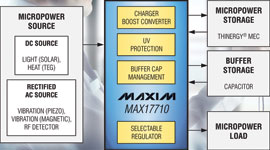Energy harvesting IC
9 November 2011
Electronics Technology

Maxim débuted the MAX17710, integrating all of the power management functions for ambient energy harvesting, as well as for charging and protecting micro-energy cells (MECs), a form of solid-state battery.
Operating at an ultra-low current level, the IC accepts energy from a variety of poorly regulated energy harvesting sources with output levels ranging from 1 μW to 100 mW. Examples include light (captured by photovoltaic cells), vibration (captured by a piezoelectric element), heat (captured by a thermoelectric generator) and RF (eg, near-field communications (NFC)).
The MAX17710 integrates a programmable input boost regulator and needs no expensive external components to charge a MEC with energy sources as low as 0,8 V. It protects the MEC by using a linear shunt series regulator. A low quiescent current, adjustable low-dropout linear regulator (LDO) with selectable voltages of 3,3 V, 2,3 V or 1,8 V allows the device to adapt to a variety of loads. Packaged in a low-profile 0,5 mm TQFN, the chip enables thin, card-like applications. It will also be available in wafer form to enable even thinner form factors.
At very low temperatures, all batteries exhibit increased characteristic impedance, which limits high pulse currents to the application loads. The MAX17710 integrates a feature that manages an external storage capacitor to augment the battery output and provide high pulse currents, even at very cold temperatures down to -40°C.
The device also works in power bridging applications where energy harvesting is not necessarily used. In such applications, infrastructure power (from the grid or a larger battery) is typically available to power the system and can trickle-charge an MEC for memory or RTC backup power. In the event of a loss of grid power or a system brownout during replacement of the larger system battery, the stored energy in the MEC continues to power volatile memory and/or an RTC for hours, days or even weeks. This solution displaces bulky coin cells and supercapacitors that have high self-discharge currents and limited life, especially at elevated temperatures.
The MAX17710 is targeted at powered smartcards, real-time clock (RTC)/memory backup applications and wireless sensor networks. Examples of wireless sensor networks include remote applications like irrigation valve control, building energy management, machine monitoring systems, asset tracking, biometric security systems, medical applications and a myriad of portable consumer electronics.
Further reading:
140 W USB-C PD reference design
Altron Arrow
Electronics Technology
The design has a wide input range of 90 to 264 V AC, 50-60 Hz, and supports an output voltage range of 5 to 28 V (USB-PD 3.1 specification).
Read more...
Nanometre-precision piezo actuators
RS South Africa
Electronics Technology
TDK Corporation has announced two new piezo actuators that are characterised by a wide dynamic range, a high force-to-volume ratio, but with precision in the nanometre range.
Read more...
Webinar: The evolving electrification of the power distribution system
Electronics Technology
New connected car functionality, along with the necessity to reduce the cost, weight and complexity associated with wire harnesses, has led to the transformation of the power distribution system in automotive engineering.
Read more...
Improved MnZn material for power conversion industry
Sivan Electronic Supplies
Electronics Technology
Cosmo Ferrites Ltd, a leading manufacturer of soft ferrites, has launched an improved version of CF295 for the power conversion industry.
Read more...
Common mode filter for automotive Ethernet
Avnet Abacus
Electronics Technology
TDK Corporation has announced the introduction of its new ACT1210E Series common mode filter for automotive Ethernet 10BASE-T1S.
Read more...
Energising the industrial edge
Electronics Technology
As if the drive to decarbonise energy as part of sustainability and climate change efforts was not enough, the recent rise in energy prices has brought into sharp contrast the need to re-examine how we generate, distribute, and consume electricity.
Read more...
Samsung begins chip production using 3 nm process technology
EBV Electrolink
Electronics Technology
The optimised 3 nm process with GAA architecture achieves 45% lower power usage, 23% improved performance and 16% smaller surface area compared to 5 nm process.
Read more...
Panasonic releases its updated touch-sensitive knob
Altron Arrow
Electronics Technology
Panasonic, in conjunction with Microchip, has launched an update to its existing Magic Knob, a capacitive knob ready for standard touch sensors for use in controlling automotive information displays.
Read more...
Microchip’s new IC to replace Hall effect position sensors
Altron Arrow
Electronics Technology
The LX34070 IC from Microchip is set to help accelerate the global move away from expensive and less accurate magnet-based solutions for safety-critical EV motor position monitoring.
Read more...
A brief history of HBTs
Conical Technologies
Electronics Technology
In 1947 the engineers at Bell Labs were tasked with developing a transistor. This development heralded the beginning of the semiconductor industry which changed the world forever. Transistors would have
...
Read more...


